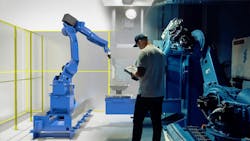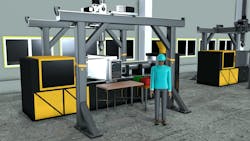Simulations, digital twins make processes more efficient
By Bruce Geiselman and Lynne Sherwin
Simulation, digital-twin and data-analysis technologies allow manufacturers to play Goldilocks — testing out all the available options until they find the one that’s just right.
That’s how Graham Wloch, director of business development for Visual Components North America, Inc., describes it.
Visual Components provides simulation and robot offline programming software that the company calls cradle-to-grave solutions for manufacturers to optimize their operations. The company supports a wide range of industries, including aerospace, agriculture, automotive and plastics.
Visualization, simulation and analysis tools like Visual Components’ help companies understand their processes better, enabling data-driven decisions that can turn a marginal company into an industry leader, Wloch said.
“It’s surprising the number of companies you talk to that are still using Excel sheets and PowerPoints and 2D drawings to try and understand what it is that they not only have, but try and predict where they want to go. Sometimes they get lucky, sometimes it’s right, but it’s a very difficult, hard to understand, time-consuming process,” he said.
Visual Components’ platform enables proactive decision-making from the very beginning, by simulating processes virtually before equipment is even installed, Wloch said, allowing for the most efficient designs of manufacturing plants.
After processes are up and running, the software can use virtual twin technology to improve efficiency. Virtual twin technology, unlike simple simulation, uses real-time data from equipment to create a live twin of a running production environment. The platform allows users to replay processes and make changes to those processes to predict the outcome.
“You collect all of that data, so you’ve got real production information, and then at your leisure, you can go back, replay that and actually make changes within the environment to say, ‘If we had done this, this would have been our result; if we had optimized this or added a resource or moved something around with that same process and manufacturing data, this would have been our result,’ ” Wloch said.
Because the software is aimed at a wide range of industries, its out-of-the-box capabilities are aimed at general process improvements such as machine and operator utilization. But it has an open API, so a plastics processor can tailor it to perform more complex and granular analysis.
For example, if a plastics processor were to input processing information about different resins, the software could help the user determine the outcome of switching materials for a given project.
“If you’re into it at the level of digital twin — very few people actually get there, but if you’re in at that level — you obviously have the capability to customize the simulation environment for your needs and your best practices,” Wloch said.
The platform supports virtual-reality training for line operators, such as teaching them how to use an HMI before the equipment is installed. It can reduce the learning curve and downtime, while giving the people who do the work a stake in the process.
“What we offer is a virtual-reality environment where line operators and people on the floor doing those jobs can actually be immersed in the process and say, ‘Hey, let’s move this here. Let’s do this here. Let’s make this change,’ so you can do that ahead of installation instead of after the fact. It cuts down on downtime, mistakes, and then increases the efficiency of what they’re able to do,” Wloch said.
In addition to software that assists with training and process optimization, Visual Components offers robotic programming software that can improve the efficiency of robots and their motions. Visual Components Robotics OLP can bring a customer’s technology deployments under one banner, improve robot utilization and enhance production efficiency.
The software is offered on a subscription basis with costs starting at less than $10,000 annually. It is user-friendly and does not require extensive training. The company aims to make simulation software accessible to businesses of all sizes, Wloch said.
“Nobody walks into a manufacturing facility, just takes a look around and says, ‘Oh, that’s the problem.’ ... It’s living, it’s breathing, it’s a process in and of itself,” Wloch said. “So, when you're able to take a step back and look at that macro level, through the visualization and the simulation, and focus on individual parts while still understanding the whole, it really makes it easy for people to decide what ... ultimately, the biggest benefit or impact will be of automation and things like that.”
About the Author
Bruce Geiselman
Senior Staff Reporter Bruce Geiselman covers extrusion, blow molding, additive manufacturing, automation and end markets including automotive and packaging. He also writes features, including In Other Words and Problem Solved, for Plastics Machinery & Manufacturing, Plastics Recycling and The Journal of Blow Molding. He has extensive experience in daily and magazine journalism.
Lynne Sherwin
Managing Editor
Managing editor Lynne Sherwin handles day-to-day operations and coordinates production of Plastics Machinery & Manufacturing’s print magazine, website and social media presence, as well as Plastics Recycling and The Journal of Blow Molding. She also writes features, including the annual machinery buying survey. She has more than 30 years of experience in daily and magazine journalism.


